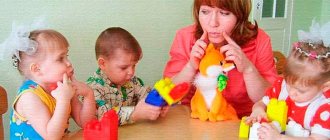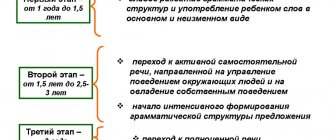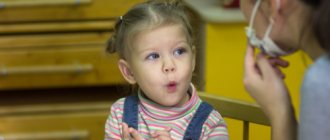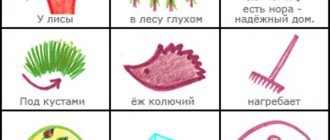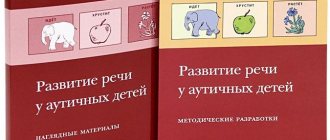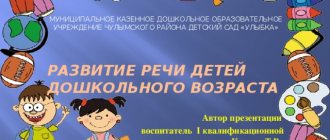Methods and techniques for developing children's speech in preschool institutions
A short mind has a long tongue. Aristophanes
IS - information block
Text No. 1.
The methodology uses methods developed in didactics. (See: Radina E.I. Teaching methods//Issues of teaching in kindergarten/Ed. A.P. Usova. - M., 1955; Fundamentals of preschool pedagogy/Ed. A.V. Zaporozhets, T.A Markova. – M., 1980.)
The method of speech development is defined as a way of activity of the teacher and children, ensuring the formation of speech skills and abilities.
Methods and techniques can be characterized from different points of view (depending on the means used, the nature of the cognitive and speech activity of children, the section of speech work).
Generally accepted in the methodology (as in preschool didactics in general) is the classification of methods according to the means used: visualization, speech or practical action. There are three groups of methods - visual, verbal and practical. This division is very arbitrary, since there is no sharp boundary between them. Visual methods are accompanied by words, and verbal methods use visual techniques. Practical methods are also associated with both words and visual material. The classification of some methods and techniques as visual, others as verbal or practical depends on the predominance of visibility, words or actions as the source and basis of the statement.
Visual methods are used more often in kindergarten. Both direct and indirect methods are used. The direct method includes the observation method and its varieties: excursions, inspections of the premises, examination of natural objects. These methods are aimed at accumulating the content of speech and providing communication between two signaling systems.
Indirect methods are based on the use of visual clarity. This is looking at toys, paintings, photographs, describing paintings and toys, telling stories about toys and paintings. They are used to consolidate knowledge, vocabulary, develop the generalizing function of words, and teach coherent speech. Indirect methods can also be used to get acquainted with objects and phenomena that cannot be encountered directly.
Verbal methods are used less frequently in kindergarten: reading and storytelling of works of art, memorization, retelling, general conversation, storytelling without relying on visual material. All verbal methods use visual techniques: showing objects, toys, paintings, looking at illustrations, since the age characteristics of young children and the nature of the word itself require visualization.
Practical methods are aimed at using speech skills and abilities and improving them. Practical methods include various didactic games, dramatization games, dramatizations, didactic exercises, plastic sketches, and round dance games. They are used to solve all speech problems.
The characteristics of speech development methods outlined above do not fully take into account the essence of students’ speech activity itself. In school methodology, there is a search for ways to intensify methods of work to develop students’ speech, taking into account the nature of speech. An analysis of the methods of speech development in kindergarten from these positions will also make it possible to understand the role and place of each method in the formation of children’s language ability.
Depending on the nature of children’s speech activity, reproductive and productive methods can be roughly distinguished.
Reproductive methods are based on reproducing speech material and ready-made samples. In kindergarten, they are used mainly in vocabulary work, in the work of educating the sound culture of speech, and less in the formation of grammatical skills and coherent speech. Reproductive methods can conditionally include methods of observation and its varieties, looking at pictures, reading fiction, retelling, memorizing, games-dramatization of the content of literary works, many didactic games, i.e. all those methods in which children master words and the laws of their combination, phraseological phrases, some grammatical phenomena, for example, the management of many words, master by imitation of sound pronunciation, retell close to the text, copy the teacher’s story.
Productive methods involve children constructing their own coherent utterances, when the child does not simply reproduce the language units known to him, but selects and combines them in a new way each time, adapting to the communication situation. This is the creative nature of speech activity. From this it is obvious that productive methods are used in teaching coherent speech. These include generalizing conversation, storytelling, retelling with text restructuring, didactic games for the development of coherent speech, modeling method, creative tasks.
There is also no sharp boundary between productive and reproductive methods. There are elements of creativity in reproductive methods, and elements of reproduction in productive ones. Their ratio fluctuates. For example, if in a vocabulary exercise children choose from their vocabulary the most suitable word to describe an object, then in comparison with the same choice of a word from a number of given ones or repeating after the teacher when viewing and examining objects, the first task is more creative in nature. In independent storytelling, creativity and reproduction can also manifest themselves differently in stories based on a model, plan, or proposed topic. Characterization of well-known methods from the point of view of the nature of speech activity will make it possible to more consciously use them in practice with children.
Depending on the task of speech development, methods of vocabulary work, methods of educating the sound culture of speech, etc. are distinguished.
Methodological techniques for developing speech are traditionally divided into three main groups: verbal, visual and playful.
Verbal techniques are widely used. These include speech pattern, repeated speaking, explanation, instructions, assessment of children's speech, question.
A speech model is a teacher’s correct, pre-thought-out speech activity, intended for children to imitate and guide them. The sample must be accessible in content and form. It is pronounced clearly, loudly and slowly. Since the model is given for imitation, it is presented before the children begin their speech activity. But sometimes, especially in older groups, a model can be used after children’s speech, but it will not serve for imitation, but for comparison and correction. The sample is used to solve all problems. It is especially important in younger groups. In order to attract children's attention to the sample, it is recommended to accompany it with explanations and instructions.
Repeated pronunciation is the deliberate, repeated repetition of the same speech element (sound, word, phrase) with the aim of memorizing it. In practice, different repetition options are used: behind the teacher, behind other children, joint repetition of the teacher and children, choral repetition. It is important that repetition is not forced, mechanical, but is offered to children in the context of activities that are interesting to them.
Explanation - revealing the essence of certain phenomena or methods of action. Widely used to reveal the meanings of words, to explain the rules and actions in didactic games, as well as in the process of observing and examining objects.
Directions – explaining to children the method of action to achieve a certain result. There are instructional, organizational and disciplinary instructions.
Assessment of child speech is a motivated judgment about a child’s speech utterance, characterizing the quality of speech activity. The assessment should not only be of a stating nature, but also educational. The assessment is given so that all children can focus on it in their statements. Assessment has a great emotional impact on children. It is necessary to take into account individual and age characteristics, to ensure that the assessment increases the child’s speech activity, interest in speech activity, and organizes his behavior. To do this, the assessment primarily emphasizes the positive qualities of speech, and speech defects are corrected using a sample and other methodological techniques.
A question is a verbal address that requires an answer. Questions are divided into main and auxiliary. The main ones can be ascertaining (reproductive) - “who? What? Which? which? Where? How? Where?" and search, requiring the establishment of connections and relationships between phenomena - “why? For what? how are they similar? Auxiliary questions can be leading and suggestive. The teacher needs to master the methodologically correct formulation of questions. They must be clear, focused, and express the main idea. It is necessary to correctly determine the place of logical stress in a question and direct children’s attention to the word that carries the main semantic load. The structure of the question should serve as an example of interrogative intonation and make it easier for the child to answer. Questions are used in all methods of children's speech development: conversations, discussions, didactic games, and when teaching storytelling.
Visual techniques - showing illustrative material, showing the position of the organs of articulation when teaching correct sound pronunciation.
Game techniques can be verbal and visual. They arouse the child’s interest in activities, enrich the motives of speech, create a positive emotional background of the learning process and thereby increase children’s speech activity and the effectiveness of classes. Gaming techniques meet the age characteristics of children and therefore occupy an important place in native language classes in kindergarten.
Structural and logical diagram 1. Methods and techniques for speech development (Sterlikova V.V.).
In preschool pedagogy, there are other classifications of teaching methods. Thus, depending on their role in the learning process, direct and indirect methods are distinguished. All of the above verbal techniques can be called direct, and a reminder, remark, remark, hint, advice - indirect.
Structural and logical diagram 2. Methods of developing children's speech.
In the real pedagogical process, techniques are used comprehensively. So, in a generalizing conversation, various types of questions, showing objects, toys, paintings, playing techniques, artistic expression, evaluation, and instructions can be used. The teacher uses different techniques depending on the task, the content of the lesson, the level of preparedness of the children, their age and individual characteristics.
Why is it necessary to characterize speech development methods from the point of view of the nature of children’s speech activity?
Why are productive methods needed?
Literature:
Alekseeva M. M., Yashina B. I. Methods of speech development and teaching the native language of preschoolers: Textbook. aid for students higher and Wednesday, ped. textbook establishments. — 3rd ed., stereotype. — M.: Publishing House
“Site help” - click on the arrow image - hyperlink to return to the previous page (module 3).
In order to return to the MAIN page from any page of the site, just click on the full name of the site’s author (Golskaya Oksana Gennadievna), also located in the upper right corner of the page.
Monologue speech
The statement of one person addressed to listeners is called monologue speech or monologue.
Signs of this form of speech:
- duration;
- volume;
- structure;
- easily changeable topic of the statement.
There are two types of coherent monologue:
- addressed to listeners (report, lecture, public performance);
- addressed to oneself, i.e. not expecting a response.
Mastery of monologue speech requires certain skills:
- the use of speech structures to intelligently express one’s thoughts;
- narrative and descriptive messages on a topic using story pictures;
- compiling descriptive texts according to the plan.
Methods for developing monologue speech
The method of teaching coherent monologue speech involves:
- formation in students of certain skills of expressing their thoughts with the help of learned materials;
- improving skills with support exercises.
Any type of monologue - story, description, retelling - requires some kind of support.
By support we mean:
- situations;
- prepared material (questions, descriptions);
- ready-made texts;
- visual situations;
- ready-made structures;
- logic.
